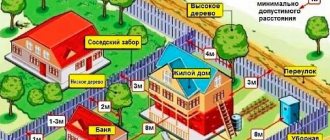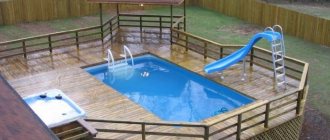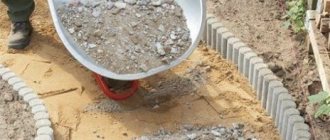Rules for placing a toilet in a summer cottage
A toilet on a summer cottage or on a plot of land in a private residential sector cannot be located close to the water intake.
The distance from a regular well should be 50 m, and from a well with casing pipes 30 m. If your site is located in the water protection zone of reservoirs and rivers, then this distance increases to 200 m. In fact, residential areas have an even greater restriction on the location of toilets the buildings. According to Sanpin 42-128-4690-88 “Sanitary Rules for the Maintenance of Populated Areas,” yard latrines should be located away from residential buildings, all kinds of children’s institutions, such as schools, kindergartens and even playgrounds. The minimum distance is 20 m, but the distance to the toilets, even if they are yard latrines, from children's institutions should be no more than 100 m. But there are some relaxations; for private housing construction, the distance to the latrine is determined by the homeowners themselves and it is allowed to reduce this distance to 8-10 m. Just don’t forget about the neighbors. They may not agree that the distance from your restroom to their house should be less than 30 m. In this case, a commission of local councils will sort out the conflict. How you can come to an agreement is a separate question, but judicial practice shows that the court may well take your side, but, anyway, the minimum distance to the neighbor’s house should not be less than 8 m. which, it should be noted, is not so little , if the neighbor’s house is built in compliance with building codes and regulations, it cannot be located closer than 3 m from the border of the plots, that is, closer than 5 m from the fence for your toilet is a prohibited zone.
Other important restrictions. The depth of the cesspool depends on the groundwater level, but in any case, it should not be more than 3 m. If we remember, in the village, when filling the hole, they simply dug a new one. It is clear that no one has concreted such pits. Today, a cesspool must be waterproof, it’s just that pits are not even provided for by the rules. True, the method by which waterproofness is achieved is not specified, therefore, it could be a metal caisson, concrete rings, etc. You simply cannot move such a pit, so a cesspool with a lid is required. That is, it is assumed that the pit will be cleaned regularly.
Russian gardening associations are often “decorated” with numerous restrooms. Few people think that installing an ordinary cesspool on a plot of land can lead to administrative liability.
According to paragraph 8.7 of the Russian building codes and regulations SNiP 30-02-97, in the absence of a central sewerage system, it is necessary to use powder closets and dry closets. But the construction and use of cesspools (closets and outhouses) must be approved at the design stage by local authorities for the regulation, use and protection of groundwater and by the sanitary and epidemiological service (SES). Collecting household water (shower, bath) can be done in a filter trench with gravel-sand backfill or, in agreement with the SES, in an external ditch along a specially organized ditch (the same SNiP, clause 8.8).
The rules are uniform, but each region has its own system for monitoring their implementation, so the approval procedure has to be clarified on the spot. When building a “toilet-birdhouse” on their site, few people burdened themselves with such troubles. And many do not even suspect the existence of norms and rules. And almost everywhere, a cesspool is a filter well that replenishes groundwater with its contents. It can be argued that in villages such latrines have been standing for decades and no one has any complaints about them, that such pits are far from the aquifer, and with seasonal use they do not even have time to fill. But times are changing. Suburban settlements are growing, and with them the requirements for compliance with environmental standards and regulations. It is forbidden to dump human waste into the ground.
Terms from SNiP 30-02-97 “Planning and development of territories of gardening associations of citizens, buildings and structures”, taking into account the changes of 2001.
Dry toilet
- a device for processing fecal waste into organic fertilizer by using a biological oxidation process activated by electrical heating or chemical additives.
Backlash closet
- an in-house warm latrine with an underground cesspool, into which feces enter through a sewer pipe. Ventilation is carried out through a special backlash channel adjacent to the heating devices, and the cesspool is located outside.
Outhouse
- a lightweight building placed above a cesspool.
Powder closet
- a toilet in which fecal waste is treated with a powdered composition, usually peat, and kept dry in an insulated container (a tarred box with a lid) until compost is formed.
Forewarned is forearmed
What are the dangers of old waste disposal methods? According to the second part of Article 8.6 of the Code of Administrative Offenses, the discharge of waste and household water can be regarded as damage to land. And this entails an administrative fine in the amount of 1.5 to 2,000 rubles (relevance - January 2011).
For the first time, the inspector can get by with a warning (such violations are too widespread in our country), but on subsequent visits fines cannot be avoided. And they will increase if the toilet is located close to a reservoir or well (by the way, the toilet from a residential building should be 12 m away, and from the well - 8 m).
How to dispose of waste legally? There are three options: a sealed storage tank made of plastic or metal, emptied by a sewer truck, a septic tank or a local treatment facility (LWF). In the latter case, you cannot do without bureaucratic attention - permission for installation and registration must be obtained from the SES, and each region has its own procedure for registration. So, before the inspector comes to check you, think about what can be done to prevent the cesspool from becoming a “cesspool”. Try contacting the chairman of the gardening association first. Maybe the founding documents already contain agreement with the sanitary services to install toilets for the entire village.
10 best articles on the topic: Country toilets: installation rules
Country toilets: installation rules on Supersadovnik.ru
Country toilets
:
installation rules
. Text: Anastasia Anisimova. Toilet paper. Russian gardening associations are often “decorated”...Toilets and showers in a summer cottage - Kniga.com
Choosing a place for a country toilet:
rules for a country toilet
:
install
a powder closet with...Introduction - ?Toilet - ?Types of toilets - ?Choose the appropriate option
Sanitary standards for installing a closet on a village plot
31 Oct 2011 …
How to properly, according to sanitary standards,
install
a wooden
toilet
on a plot in a village.
I found the norms at the dachaCountry toilets: installation rules
Country toilets
:
installation rules
Russian gardening associations are often “decorated” with numerous restrooms. Not many people who …Country toilet drawings and installation instructions
If you have drawings of a country toilet
, positive attitude, ...
the country toilet
must comply with sanitary
rules
and regulations.Rules for building a country toilet - 1landscapedesign.ru
Installation
frame;
Installation of walls, doors and roof; Arrangement of internal “conveniences” of an outdoor toilet
.
Considering that not all country houses
...Toilet in the country, building a toilet in the country with your own hands...
1 Aug 2011 …
If
the toilet or septic tank for the dacha
is installed installation
complied with
the rules
that are enshrined in ... the dacha well, then the construction
dacha toilet
, ...Wooden toilet in the country - TverEkoStroy LLC
Don't flout the rules
country toilet
devices .
... ready for use and you can proceed to installing
the upper part
of the country toilet
.Toilet for a summer residence, rural toilet. Tips, ideas. - TOILET . RU
Sanitary norms and rules
regulating the design, construction, ... How to choose a toilet for a summer house (
dacha toilet
)?
... backlash-closets, powder-closets and install
a reliable dry toilet on your site.Demin Sergey Vitalievich Toilets and showers in a summer cottage
Choosing a place for a country toilet
requires compliance with some
rules
.
... two possibilities for organizing a country toilet
:
install
a powder closet with ...
In previous articles, I have already considered the issue of for my country house and how. The availability of water at least within walking distance and the choice of a method of waste disposal (including human activity) are tasks that sometimes require complex engineering solutions. And the first stage in meeting these needs, as in any construction activity, is design. That is, drawing up a design scheme that takes into account not only the requirements of users, but also sanitary standards and rules.
Toilet in the country: distance from neighbors, other important norms

The toilet in the country must be located in such a way as to maintain the permissible distance from neighbors. Otherwise, disagreements and sometimes litigation cannot be avoided.
Toilet in the country: distance from neighbors
Installation rules are regulated by Building Codes and Regulations (SNiP). Also, the requirements for land owners are prescribed in the regulations of land management organizations and local authorities. Violation of the rules established by law may lead to administrative consequences, so it is important not to violate them.
The permissible minimum distance of a country toilet from a neighbor’s fence is 1 meter. If you move the building closer, you are more likely to encounter problems in the future.
About dacha “conveniences”
Dacha... For some it is luxurious, full of wonderful, entwined or... Another cannot imagine a dacha without food, in which the harvest is ripening, and enough to eat enough during the season and make enough for the winter, and even so that there is enough for relatives and friends. The third believes that today you can buy anything all year round at the supermarket, but yes, this is something without which a country holiday is not a holiday.
But no matter how the owners of a country house formulate their preferences, there is one thing that unites both an avid gardener and a lover of bathhouses and barbecues. Something that is sure to exist on any site, even the smallest one. This . With the construction of this building, the development of the site and the construction of the house begin.
Depending on the conditions and financial possibilities, country estates vary. Actually, the differences lie in the method of disposal of natural products of human activity. The diagram shows the general classification of latrines.
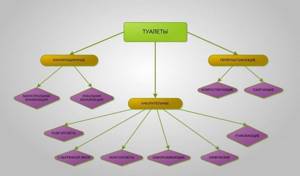
Strictly speaking, all the toilets listed in the diagram are recycling: organic waste, through biological processes involving microorganisms, is converted into a set of chemical elements and simple compounds suitable for plant nutrition. This process is called the biological cycle of substances in nature
. It constantly moves around us - in the soil, in reservoirs, in the compost heap, finally.
The only difference is that in the design of storage toilets and those connected to the main sewerage system, the recycling process does not occur - the waste is transported in one way or another to the final processing site. In truly refining
devices and local sewerage, decomposition to a safe or useful state occurs directly in the system itself. Let's take a closer look at each type of toilet.
- Toilet with connection to the main sewerage system
In some villages, there are urban amenities - a main sewer system, which means the possibility of installing a regular flush toilet, familiar to city residents. But in most cases about this
Country property owners can only dream.

- Toilets with connection to local sewerage
Local or autonomous sewerage is a complex that includes a treatment plant and utilities connecting toilets, sinks, etc. in a house with a storage tank. In this case, a flush toilet can be installed, and the toilet in
takes on the appearance familiar to a city dweller. The design of the local sewage system is also different: it can be a septic tank with subsequent post-treatment of wastewater in the soil or a special reservoir, or a local treatment system (VS) that purifies wastewater to the required standards.
- Cesspool toilets
The simplest toilet for a summer house is
a toilet with a cesspool
. Sewage simply accumulates in the container, and then it is either emptied by special sewage disposal machines or by the owner himself, or preserved (in the case where the container is an ordinary pit) - it is filled up and some kind of fast-growing tree is planted on top. Next, the structure of the country toilet is transferred to another place, to a new pit, and everything starts from the beginning. It should be taken into account that this method - with transfer - is possible only if there is free space on the site and provided that the pit for sewage is very small, that is, located exclusively in the upper soil horizon.

- Backlash closet
One of the varieties of ordinary
, only more thoroughly arranged -
a backlash closet
.
Such toilets are not equipped as a separate building (such as a “birdhouse”), but as an extension to a residential building. They are warm and have separate ventilation for the cesspool (in addition to the ventilation of the toilet room itself). Hence the name: “luft”
in German means air.
- Powder closets and peat toilets
In toilets, human waste is placed in a small container (for example, a bucket) located under the toilet seat, and after each use it is sprinkled (“powdered”) with peat or other hygroscopic bulk material. This prevents the appearance of unpleasant odors and the proliferation of insects. Once the container is full, it is emptied into the compost heap, where the feces are finally processed into compost.
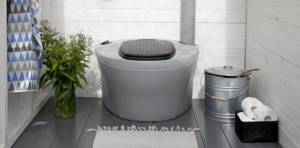
- Composting or recycling toilets
— more advanced, having a larger capacity for collecting waste. The processing of sewage into fertilizer occurs not in the compost heap, but in the toilet structure itself. Some models have a separate device that separates waste products into solid and liquid fractions. Feces separated from urine quickly turn into compost, and urine collected separately can be immediately used as fertilizer. Separation also reduces odor.
- Chemical toilets
For some reason, the common name for such toilets is the term
, although no special
“bio”
is provided for in the design.
Waste is processed using special chemicals contained in cartridges. The substance obtained as a result of chemical reactions must be disposed of. There are options for chemical reagents for toilets based on formaldehyde
- a substance that does not decompose organic waste, but preserves it. Formaldehyde is used in their work by taxidermists and embalmers of corpses.
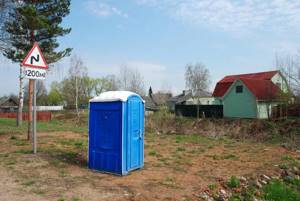
- Toilets that burn, freeze and pack sewage
Various options for thermal toilets (those that treat feces with temperature) are quite energy-intensive. For example, models that burn waste consume about 3-5 kW/h. Frozen or bagged feces require manual disposal, such as in a compost heap. Packed ones, by the way, need to be “neutralized” quite quickly: in the bag, the processes of natural decomposition of organic matter continue, and the consequence of this is the release of gases that can tear the container. With all the ensuing consequences.
Frozen waste remains frozen only while the device is connected to the network. In the event of a power outage - well, you know, your refrigerator was defrosting when the power suddenly went out. Therefore, such latrine designs are more suitable as a mobile option.
What the toilet will be like, of course, depends on the owner. But when choosing, you should focus not only on your desires and capabilities, but also on the requirements of regulatory documents. There are general rules and specific recommendations depending on the wastewater treatment system. Also, we should not forget about the so-called “gray”
drains: from showers, sinks, washing machines and dishwashers.
If there is a sewerage system (main or local), the “gray” drains are combined with the “black”
from the toilet. If drainless toilets are used, gray wastewater must also be properly disposed of.
How Ivan Ivanovich quarreled with Ivan Nikiforovich...
Building a toilet in a densely populated area can be a real headache for the owner and cause quarrels with neighbors. When drawing up a site plan, you need to start not with deciding where the cabbage beds or flower bed will be, not with choosing a place for a recreation area, but with where you will place the yard toilet, septic tank or VOC. Because there are quite strict sanitary standards for the installation of a toilet, as well as places for storing household waste and compost heaps.
The task of choosing a location becomes more complicated for those who have a small plot of land and are surrounded by neighbors with equally small plots of land. After all, it is not only on your own property that you need to maintain the distance from the toilet to the water source or residential buildings prescribed by regulatory documents: it is no good if a neighbor’s well is in close proximity to your toilet.

Failure to comply with sanitary standards may result in punishment in the form of a fine and an order to correct the violations. How to place a toilet so as not to offend yourself, and not to quarrel with your neighbors, and to comply with the law? First you need to study these very norms and requirements.
Regulatory documents, or how not to let things go to waste
Well, of course, violators of sanitary standards do not face imprisonment, but administrative punishment for improper installation of a toilet on site in the form of a fine is quite possible. And ignorance of the law does not exempt you from responsibility.
Code of the Russian Federation on Administrative Offenses
Code of Administrative Offenses of the Russian Federation No. 153-FZ was adopted on December 30, 2001. In the context of installing a toilet in a dacha, the text of this document contains interesting article 8.6 of the Code of Administrative Offenses of the Russian Federation “Damage of land”. Paragraph 2 of this article states that “... damage to land as a result of violation of the rules for handling... substances and production and consumption waste hazardous to human health and the environment... entails the imposition of an administrative fine on citizens in the amount of three thousand to five thousand rubles” . Both officials and legal entities are punished with fines.
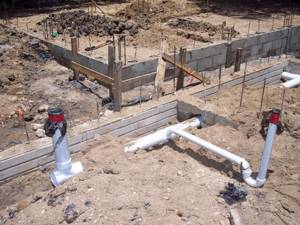
If the toilet on the site is not installed correctly, the owner can be held administratively liable for damage to the land: if the cesspool is not airtight. For example, when a well without a bottom is used as a pit, or if the quality of wastewater treatment does not meet the standards. Let's look at excerpts from some documents - construction and sanitary norms and regulations.
SNiP 30-02-97 Planning and development of territories of gardening associations of citizens, buildings and structures
This document regulates the type of toilet for non-sewered collection of feces. It is allowed to install composting toilets and biotoilets (in which organic waste decomposes using “chemistry” not based on formaldehyde). You can also arrange a backlash closet and an outhouse. For the construction of cesspool-type toilets, coordination with local SES authorities and with institutions involved in regulating the processes of protection and use of groundwater is required. If you are developing a site in a developed gardening area, contact the administration: they may already have approved plans for installing toilets.

The use of backlash closets and latrines is not allowed in the IV and III (B subdistrict) climatic zones. For those who are not familiar with building climatology, I will explain that these zones cover the south of Russia and the southern republics of the former USSR: the average monthly temperature in these territories in January is from -2°C to +5°C, the average temperature in July is from +25° WITH.
The distance from the cesspool-type outhouse to the main structures on the site is also regulated by SNiP. So, the toilet must be located at least 12 meters from the residential building, or. And 8 meters from a source of drinking water. In addition to the toilet, the same distances must be observed for the storage area for household waste and facilities for.
![]()
Do not forget that the specified sanitary zone applies not only to your house, cellar, well and playground: there must be at least 12 meters from the latrine or compost heap to your neighbors’ houses, their cellars and playgrounds. And 8 meters to neighboring sources of drinking water.
If you chose construction as the design of the toilet, then the sanitary standards for its placement are different. Household wastewater (from a bathhouse, shower, sink, etc.) may be discharged into a filter ditch backfilled with a sand-gravel mixture. It is possible to discharge “gray” wastewater into a ditch running along the outer perimeter of the site.
SanPiN 42-128-4690-88 Sanitary rules for the maintenance of populated areas
SanPiN 42-128-4690-88 describes in more detail the design of a cesspool toilet and the requirements for the conditions of its maintenance. So, for example, from this collection of rules you can learn that the cesspool must be sealed, its depth cannot exceed 3 meters, and the bottom must be located above the groundwater level. The pit can be made from
, made of bricks or blocks.
A cesspool is a must
must have a bottom, and the walls and the junction of the bottom must be waterproofed, for example, by plastering with cement-sand plaster with a final iron surface. If the groundwater level is high, then the outer surface of the sewage collection bin is additionally waterproofed. You can use sealed plastic or metal containers as a cesspool.

The volume of the pit is calculated taking into account the number of users. In any case, the volume should be such that when cleaning the pit at least once every six months, the filling of the pit should not be higher than 350 mm from the ground surface. The structure of the toilet itself can be made of bricks, blocks or wooden planks, fitted tightly, without gaps, to provide protection from the penetration of insects and rodents.
The toilet area must be cleaned regularly using disinfectants such as 10% bleach, 3-5% sodium hypochloride and other agents.
SanPiN 2.1.2.1002-00. Sanitary requirements for the design, reconstruction, construction and maintenance of operational residential buildings and premises for permanent residence
If we talked above about dachas (small country houses for seasonal living), then SANPIN 2.1.2.1002-00 establishes sanitary standards for houses
. According to the drafters of the document, residential buildings must be equipped with sewerage. If connecting to a connection is impossible (main or local), in houses with 1 or 2 floors, you can use warm restrooms of the backlash-closet type. In Appendix 1 to this document, the recommended temperature for the interior of toilets is +18...+21°C.
As with country houses, there are also restrictions imposed by building climatology: such latrines can only be used in more northern areas.
SNiP 2.04.03-85. Sewerage. External networks and structures
This regulatory document contains design standards for the installation of sewer networks in houses. More precisely, groups of houses, because the requirements and standards are designed for a fairly large volume of wastewater. Therefore, it is not of great interest for individual private construction.
Although the necessary information is still there. For example, about the sanitary zone from the filtration field of the local treatment plant and the treatment plant structures themselves. In low-rise construction, when installing local treatment facilities (septic tanks or aeration plants), the following sanitary protection zones should be adopted:
- from filter trenches - 25 meters;
- from filter wells - 8 meters;
- from filtration fields with a capacity of up to 15 cubic meters per day - 15 meters;
- from septic tanks - 5 meters;
- from aeration treatment plants with a capacity of up to 700 cubic meters per day - 50 meters.
But perhaps the most interesting from the point of view of construction
in a country house, the document is a design manual issued in 1997 by the Russian Ministry of Construction.
A manual for the design of autonomous engineering systems of single-family and semi-detached residential buildings
To begin with, the decision on choosing the type of autonomous system and the project should be coordinated with the local State Sanitary and Epidemiological Supervision authorities, and in the case of wastewater discharge after treatment into a reservoir, with the environmental organization. When designing a local sewerage system, the possibility of sewage contamination of soil aquifers should be completely eliminated, that is, the containers of settling tanks, storage tanks, and pipelines must be sealed.

To construct a septic tank or sewage storage tank, you can use reinforced concrete rings or masonry made of bricks or blocks. Only all these structures must have internal waterproofing, ensuring the leakage of liquid no more than 3 liters per cubic meter of sewage per day. If the groundwater level is high, the tank must additionally be insulated from the outside.
How to determine the required drive size
One of the important issues when installing a local sewer system is the choice of the size of the storage tank or sump. Its capacity is calculated depending on the amount of wastewater. The storage tank must hold at least two weeks' worth of wastewater and be no less than the capacity of the sewage disposal machine. For those who don’t know: the capacity of modern machines is 8 cubic meters, and the two-week average water consumption (and, accordingly, drainage) of a family of three in a house with running water but no bath is about 6.3 cubic meters. Water consumption is assumed to be within the range of 120-150 liters per day per person. In the case of a bathtub, multi-point water supply and flow-through gas heaters - 10.5 cubic meters with an estimated amount of water consumed per day per person of 250 liters.
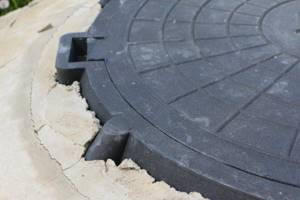
It is advisable to have septic tanks with subsequent post-treatment of wastewater in soil filtration fields, filter wells or trenches with a volume of 2.5-3 times the daily water flow. That is, for the same three people living in a house with a conventional water supply system (sink, kitchen sink, shower and toilet) - 1.3 cubic meters; for a water supply system with many water points, bathtubs and instantaneous water heaters - 2.3 cubic meters. Therefore, when buying or building a septic tank, do not try to save much and choose a cheaper option by reducing the size of the storage tank. Do not forget that septic tanks must be cleaned of accumulated sludge at least once a year. If you are ready to call a sludge pump every six months, you can reduce the volume of the septic tank by 20 percent.
Both the Ministry of Construction Manual and septic tank manufacturers recommend using local treatment facilities to treat “gray” wastewater, and treating wastewater from the toilet separately - with composting toilets, bio-toilets, backlash closets. ,
Requirements for a cesspool
The design of a country toilet in most cases involves the construction of a cesspool. It is important to carry out construction work to create a structure after agreement with the sanitary and epidemiological station. It is important to equip a tank or cesspool taking into account all sanitary standards for a summer cottage or a private house in the village.
The new facility must be included in the construction plan, which is subject to approval by government services.
The construction of a settling pit requires maintaining a certain distance from the construction site to all nearby buildings and structures. Proper placement of the toilet allows you to maintain sanitary safety in any area where a country house, cottage or cottage is located. Digging a hole is necessary in all cases, with the exception of the construction of a dry closet or backlash closet.
Typically, a country toilet involves the arrangement of a cesspool and an above-ground part. The waterproof structure must be completely sealed. Calculation of the volume of the container depends on the number of people living in the country house.
The size of the tank is also affected by the amount of wastewater generated during the day. The container should not be filled with sewage to a level exceeding 35 cm to the ground surface.
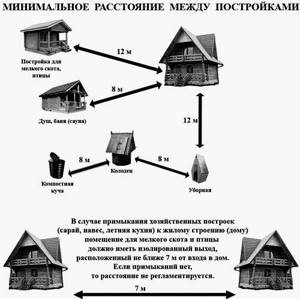
Distances between buildings on the site
